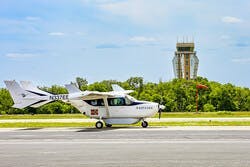April 5, the U.S. Department of Energy (DOE) Advanced Research Projects Agency-Energy (ARPA-E), the City of San Antonio Aviation Department and City Public Service Board (CPS Energy), and the University of Texas at San Antonio (UTSA) signed a Memorandum of Understanding (MOU) outlining collective efforts to develop and promote technologies that include, but are not limited to, sustainable aviation, battery technologies and innovative battery storage solutions, enhanced electric vehicle (EV) charging, and power demand management technologies.
This agreement marks the first time an international airport will work together with ARPA-E—DOE's innovation arm—to accelerate the development and deployment of new energy technologies to decarbonize the aviation sector.
ARPA-E Director Evelyn Wang, San Antonio Mayor Ron Nirenberg, UTSA President Dr. Taylor Eighmy, and CPS Energy Vice President of Customer Value Karma Nilsson were all present for the signing hosted at Stinson Municipal Airport in San Antonio.
"We are excited at this opportunity to collaborate and showcase innovative energy technologies that could transform the future of aviation," said ARPA-E Director Evelyn N. Wang. "Today's MOU signing is a step in the right direction to ensuring that these innovative technologies are developed, built, and integrated in America. Our hope is that this partnership will lay the groundwork to enable future electrified airports."
"We are proud to be a part of this innovative initiative that will ultimately benefit the San Antonio community," said Rudy D. Garza, President and CEO of CPS Energy. "CPS Energy continues to look for ways to participate in electrification projects, especially for critical public infrastructure like the San Antonio International Airport. Projects like these furthers our commitment to finding new and sustainable technologies to enable our growing community and we are excited about the opportunity to work with our community partners to do so."
"This is an important agreement with the potential to shape the aviation industry of the future," said San Antonio Mayor Ron Nirenberg. "Researching the decarbonization of aviation and finding new sustainable energy models is important work, and I am proud San Antonio will be playing a leading role in this cutting-edge research."
"This is a unique partnership designed to promote transformative energy technologies and it propels the City of San Antonio's Aviation Department to the center of innovation," said Jesus Saenz, Director of Airports, City of San Antonio Aviation Department. "This is an exciting time to be part of the Aviation Team and planning for the future of aviation and our airports."
"This collaborative effort is an incredible opportunity for UTSA to partner with strategic industry leaders in evaluating electric aircraft, advanced energy storage and micro-grid systems to advance the adoption of sustainable multi-modal transportation technologies," said UTSA President Taylor Eighmy. "Together, this collective will accelerate discoveries that will positively impact the local and regional economies while advancing technologies that change the world."
To mark this historic milestone, the following ARPA-E-funded project teams were also present to showcase their technologies and share how their innovations could be integrated into future electrified airports:
- Ampaire, who is setting new standards for sustainable air travel and eco-friendly transportation solutions, flew its cutting-edge hybrid electric EEL aircraft and watch video of the aircraft here;
- Imagen Energy showcased ultrafast, compact electric vehicle chargers delivering efficient and cost-effective power solutions;
- Natron Energy featured sodium-ion batteries that can safely store energy and efficiently deliver power on demand;
- AutoGrid discussed a distributed energy resource management system that can help grid operators manage energy supply and demand fluctuations;
- Quidnet Energy brought a wellhead to illustrate a modular geomechanical pumped storage systems that can utilize existing natural resources to store renewable energy over long durations; and
- Texas A&M University Research Team presented 3D-printed models of a motor and shared concepts for advancing efficiency in electric transportation.
UTSA and CPS Energy also presented research to leverage a city-scale grid digital twin to evaluate operational efficacy, ensure seamless interoperability, fortify cybersecurity protocols, and assess performance metrics of electric/hybrid aircrafts.
The MOU signed today will enable collaboration to identify research, development, demonstration, and deployment opportunities that will promote sustainable aviation technologies.





